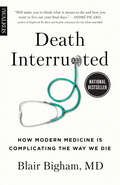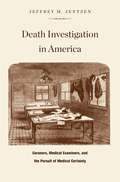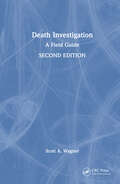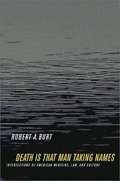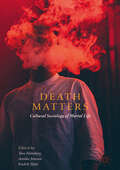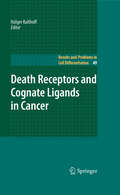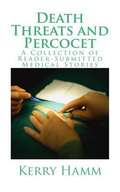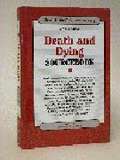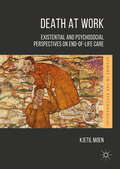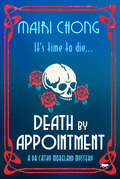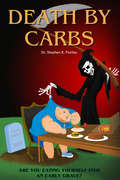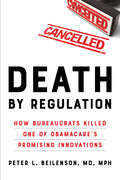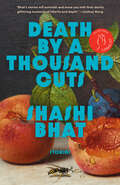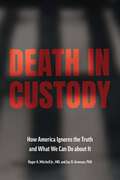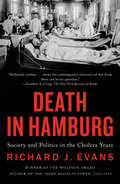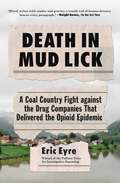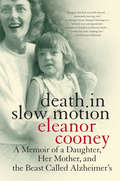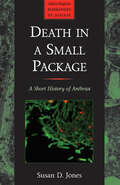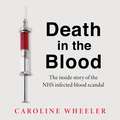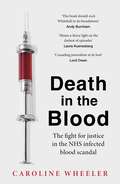- Table View
- List View
Death Interrupted: How Modern Medicine Is Complicating the Way We Die
by Blair BighamIn Death Interrupted, ICU doctor Blair Bigham shares his first-hand experiences of how medicine has complicated the way we die and offers a road map for dying in the modern era. Doctors today can call on previously unimaginable technologies to help keep our bodies alive. In this new era, most organs can be kept from dying almost indefinitely by machines. But this unprecedented shift in end-of-life care has created a major crisis. In the widening grey zone between life and death, doctors fight with doctors, families feel pressured to make tough decisions about their loved ones, and lawyers are left to argue life-and-death cases in the courts. Meanwhile, intensive care patients are caught in purgatory, attached to machines and unable to speak for themselves. In Death Interrupted, Dr. Blair Bigham seeks to help readers understand the options facing them at the end of their lives. Through conversations with end-of-life professionals — including ethicists, social workers, and nurses and doctors who practise palliative care — and observations from his own time working in ambulances, emergency rooms, and the ICU, Bigham exposes the tensions inherent in this new era of dying and answers the tough questions facing us all. Because now, for the first time in human history, we may be able to choose how our own story ends.
Death Investigation in America: Coroners, Medical Examiners, and the Pursuit of Medical Certainty
by Jeffrey M. JentzenA death occurs at home, in a hospital, on a street: why? As Jeffrey Jentzen reveals, we often never know. Why is the American system of death investigation so inconsistent and inadequate? What can the events of the assassination of President Kennedy, killing of Bobby Kennedy, and Chappaquiddick reveal about the state of death investigation? If communities in early America had a coroner at all, he was politically appointed and poorly trained. As medicine became more sophisticated and the medical profession more confident, physicians struggled to establish a professionalized, physician-led system of death investigation. The conflict between them and the coroners, as well as politicians and law enforcement agencies, led to the patchwork of local laws and practices that persist to this day. In this unique political and cultural history, Jentzen draws on archives, interviews, and his own career as a medical examiner to look at the way that a long-standing professional and political rivalry controls public medical knowledge and public health.
Death Investigation: A Field Guide
by Scott A. WagnerDeath Investigation: A Field Guide, Second Edition is updated and expanded to include a chronological analysis of the death scene investigative process from the first notification to the autopsy and final report. This book is written for the standpoints of a forensic pathologist and a forensic toxicologist emphasizing essential elements of the death investigation and how the results impact the final cause and manner of death. Topics discussed include how to assess the body at the scene and how to properly investigate natural and unnatural deaths. The book discusses various means and causes of deaths, demonstrating how death manifests in various parts of the body. A section on traumatic injuries examines and illustrates with color photographs blunt force, sharp force, gunshot wounds, and a host of other injuries that the investigator is likely to confront. Natural death conditions and disease are discussed in a separate chapter devoted to the most common manner of death. The Second Edition is fully updated with new added sections which cover forensic toxicology, statutory responsibilities, documentation and photography of the scene, DNA identification and possible contamination issues, decomposition, managing and utilizing electronic medical records, anaphylaxis and allergic reactions, infectious diseases such as Covid-19, acute peritonitis, and more. Despite including over 200 full-color photos, the book retains a succinct, handy format that is invaluable to those facing, and tasked with investigating, the reality of death on a day-to-day basis. Death Investigation: A Field Guide, Second Edition continues to serve as an invaluable resource for crime scene investigators (CSIs), coroners, medical death investigators (MDIs), and medical examiner professionals.
Death Is But a Dream: Finding Hope and Meaning in End of Life Dreams
by Christopher Kerr Carine MardorossianThe first book to validate the meaningful dreams and visions that bring comfort as death nears.Christopher Kerr is a hospice doctor. All of his patients die. Yet he has cared for thousands of patients who, in the face of death, speak of love and grace. Beyond the physical realities of dying are unseen processes that are remarkably life-affirming. These include dreams that are unlike any regular dream. Described as "more real than real," these end-of-life experiences resurrect past relationships, meaningful events and themes of love and forgiveness; they restore life's meaning and mark the transition from distress to comfort and acceptance. Drawing on interviews with over 1,400 patients and more than a decade of quantified data, Dr. Kerr reveals that pre-death dreams and visions are extraordinary occurrences that humanize the dying process. He shares how his patients' stories point to death as not solely about the end of life, but as the final chapter of humanity's transcendence. Kerr's book also illuminates the benefits of these phenomena for the bereaved, who find solace in seeing their loved ones pass with a sense of calm closure. Beautifully written, with astonishing real-life characters and stories, this book is at its heart a celebration of our power to reclaim the dying process as a deeply meaningful one. Death Is But a Dream is an important contribution to our understanding of medicine's and humanity's greatest mystery.
Death Is That Man Taking Names: Intersections of American Medicine, Law, and Culture
by Robert A. BurtIn this profound and subtle account of psychological and social forces underlying American cultural attitudes toward death, Robert A. Burt maintains that unacknowledged ambivalence is likely to undermine the beneficent goals of post-1970s reforms and harm the very people these changes were intended to help.
Death Matters: Cultural Sociology of Mortal Life
by Fredrik Palm Tora Holmberg Annika JonssonThis book investigates death as part of contemporary everyday experience and practices. Through a cultural sociological lens, it studies death as it remains constantly at the edge of our consciousness, shaping the ways in which we move through social reality. As such, Death Matters is a significant contribution to death studies, going beyond traditional parameters of the field by addressing the cultural omnipresence of death.The contributions analyse several death-related meaning-making processes, arguing that meanings emerging from culturally shared narratives, social institutions, and material conditions, are just as important as ’death practices’ in understanding the role of death in society. Drawing on the related themes of places of absence and presence, disease and bodies, and persons and non-persons, the authors explore a variety of areas of social life, from haunting to celebrity deaths, to move the notion of death from the margins of social reality to ongoing everyday life.This far-reaching collection will be of use to scholars and students across death studies, sociology, anthropology, philosophy, culture, media and communication studies.
Death Receptors and Cognate Ligands in Cancer
by Holger KalthoffDeath receptors play a central role in directing apoptosis in mammalian cells. This process of active cell death is important for a number of biological processes, e.g. for the regulation of the immune system. Death receptors are cell surface receptors that transmit apoptotic signals initiated by corresponding death ligands. Many complex signaling pathways are activated and apoptosis is the final result of a complex biochemical cascade of events. Besides their role in the induction of cell death, evidence now exists that death receptors are able to activate several non-apoptotic signaling pathways which, depending on cellular context, may lead to apoptosis resistance, secretion of pro-inflammatory proteins, proliferation and invasive growth of cancer cells. This book looks at the molecular basis of death receptor signaling and the role of death receptors in cancer development.
Death Scenes
by Sean Tejaratchi Dunn KatherineThe strange and gruesome crime-scene snapshot collection of LAPD detective Jack Huddleston spans Southern California in its noir heyday. Death Scenes is the noted forerunner of several copycat titles.
Death Threats and Percocet: A Collection of Reader-Submitted Medical Stories, Vol. 3
by Kerry HammIn the third edition of 'A Collection of Reader-Submitted Medical Stories,' Kerry Hamm presents her audience with stories submitted by first responders, hospital and SNF nurses, physicians, law enforcement, fire and rescue, obstetricians, receptionists, orderlies, and even a dentist. How did the young man receive chemical burns to his genitals? A bold (and stupid) stunt in court gets someone tossed in jail. Just how many women was that doctor sleeping with? All these questions and observations are hidden within this volume. Kerry's readers give her a run for her money on the stories they share, from the sad to the terrifying, and right down to the tears-rolling-down-your-cheeks hilarious! Jump right in and try to figure out what these people were thinking.
Death and Dollars: Solving the Epidemic of Chronic Disease
by Richard MilaniDeath and Dollars: Solving the Epidemic of Chronic Disease is a guide to navigating through the ever-changing field of healthcare while incorporating technology and other advancements to improve the quality of care and decrease illness, simultaneously improving and extending lives. The medical crisis of the 21st century is chronic disease, which means it is directly related to our behaviors and lifestyles every day. Dr. Richard V. Milani, MD, takes a look at how physicians, healthcare practitioners, administrators, and policymakers can create lasting change by empowering patients to become active partners in their own healthcare.
Death and Dying Sourcebook
by Annemarie S. MuthThis volume compiles 55 documents and excerpts from government agencies and copyrighted material from organizations and individual. They cover death and dying statistics in the US, attitudes, health care options for the terminally ill, end-of-life medical care, approaching death, final arrangements, bereavement, and additional help and information. Annotation c. Book News, Inc., Portland, OR (booknews.com)
Death at Work: Existential and Psychosocial Perspectives on End-of-Life Care (Studies in the Psychosocial)
by Kjetil MoenThis book explores how, in encounters with the terminally ill and dying, there is something existentially at stake for the professional, not only the patient. It connects the professional and personal lives of the interviewees, a range of professionals working in palliative and intensive care. Kjetil Moen discusses how the inner and outer worlds, the psychic and the social, and the existential and the cultural, all inform professionals’ experience of work at the boundary between life and death. Death at Work is written for an academic audience, but is accessible to and offers insights for practitioners in a variety of fields.
Death by Appointment (The Dr. Cathy Moreland Mysteries #1)
by Mairi ChongA doctor retreats to the Scottish coast for a fresh start—but finds herself in harm&’s way—in this compelling murder mystery. Physician Cathy Moreland needs time to heal, having recently been diagnosed with bipolar disorder while struggling with a painkiller habit. The little village of Kinnaven promises respite, but after Cathy attempts to get an opiate prescription, things don&’t go well. When she discovers the body of the local Dr. Cosgrove, her sanctuary is shattered. Before long, Cathy is swept up in local gossip about the death. Decades earlier, the cliff where Cosgrove died had been the site of another tragedy, leading some to suspicions about the doctor&’s demise. But as Cathy determines to learn the truth, she will find herself in grave danger. The Dr. Cathy Moreland Mysteries are written by a former practicing physician and praised for their &“great characters&” (Peter Boon, author of Who Killed Miss Finch?). Revised version, previously published under the same title.
Death by Carbs: Are you eating yourself into an early grave?
by Dr Stephen K. FairleyThere are three serious, widespread addictions in Western society that account for countless unnecessary and premature deaths. We all have to die sometime; these things just help to ensure our death is sooner rather than later. Tobacco and alcohol are self-explanatory and accepted without question by most people. What most of us don't seem to realise is that far more people die prematurely from carbohydrate poisoning than tobacco and alcohol combined. Premature death by carbohydrate poisoning is a slow but steady process that is potentially completely avoidable. Each year this results in the premature deaths of many millions of unsuspecting people worldwide, particularly in Western societies. Are you at risk? Do you know how to avoid this Grim Reaper that is trying to take your soul to another place before you are ready to leave? This book reviews the scientific evidence behind the claims.
Death by Regulation: How Bureaucrats Killed One of Obamacare's Promising Innovations
by Peter L. BeilensonThe story of a small healthcare startup and its fight for survival against the very federal agencies responsible for its launch as part of the ACA.In the contentious run-up to the passage of the Affordable Care Act, Congress passed a law to make nonprofit health insurance CO-OPs (formally known as Consumer Operated and Oriented Plans) a viable alternative to the public option. The idea was to create new competition in order to lower health insurance premiums and encourage innovation. Nearly two dozen such low-cost CO-OPs were launched in the wake of the ACA's passage; only four are in operation today.In Death by Regulation, Dr. Peter L. Beilenson tells the story of a group of Maryland-based public health professionals who launched the Evergreen Health Cooperative, only to discover that the ACA law encouraging CO-OPs was a "plastic plant"—a piece of legislation created for optics but never intended to be functional. Over most of its four years of existence, Evergreen succeeded against all odds, prevailing over naysayers, big insurance companies, Congress, and its founders' naïveté. But in an ironic twist, it was bureaucratic hostility from the Centers for Medicare and Medicaid Services—the very Obama administration agency responsible for the CO-OPs—that led to their collective demise.Beilenson traces the huge impact of seemingly small policy decisions on the work of his team and the people their CO-OP was built to serve. He recounts the excitement and satisfaction of launching such a valuable healthcare company, as well as the damage done to scores of employees and tens of thousands of satisfied healthcare customers when bureaucrats ran amok. The only book about these idealistic Obamacare CO-OPs and the obstacles they all faced, Death by Regulation offers an insider view of health policy and the reality of starting an insurance company from scratch.
Death by a Thousand Cuts: Stories
by Shashi BhatFrom the Governor General&’s Award-shortlisted author of The Most Precious Substance on Earth comes a breathtaking and sharply funny collection about the everyday trials and impossible expectations that come with being a woman.What would have happened if she&’d met him at a different time in her life, when she was older, more confident, less lonely, and less afraid? She wonders not whether they would have stayed together, but whether she would have known to stay away. A writer discovers that her ex has published a novel about their breakup. An immunocompromised woman falls in love, only to have her body betray her. After her boyfriend makes an insensitive comment, a college student finds an experimental procedure that promises to turn her brown eyes blue. A Reddit post about a man&’s habit of grabbing his girlfriend&’s breasts prompts a shocking confession. An unsettling second date leads to the testing of boundaries. And when a woman begins to lose her hair, she embarks on an increasingly nightmarish search for answers. With honesty, tenderness, and a skewering wit, these stories boldly wrestle with rage, longing, illness, and bodily autonomy, and their inescapable impacts on a woman&’s relationships with others and with herself.
Death in Custody: How America Ignores The Truth And What We Can Do About It (Health Equity In America Ser.)
by Roger A. Mitchell, Jr. and Jay D. AronsonDeath in Hamburg: Society And Politics In The Cholera Years, 1830-1910
by Richard J. Evans"A tremendous book, the biography of a city which charts the multifarious pathways from bacilli to burgomaster." - Roy Porter, London Review of Books Why were nearly 10,000 people killed in six weeks in Hamburg, while most of Europe was left almost unscathed? As Richard J. Evans explains, it was largely because the town was a “free city” within Germany that was governed by the “English” ideals of laissez-faire. The absence of an effective public-health policy combined with ill-founded medical theories and the miserable living conditions of the poor to create a scene ripe for tragedy. The story of the “cholera years” is, in Richard Evans’s hands, tragically revealing of the age’s social inequalities and governmental pitilessness and incompetence; it also offers disquieting parallels with the world’s public-health landscape today, including the current coronavirus crisis.
Death in Mud Lick: A Coal Country Fight against the Drug Companies That Delivered the Opioid Epidemic
by Eric EyreFrom a Pulitzer Prize–winning reporter from the smallest newspaper ever to win the prize in the investigative reporting category, an urgent, riveting, and heartbreaking investigation into the corporate greed that pumped millions of pain pills into small Appalachian towns, decimating communities. <P><P>Death in Mud Lick is the story of a pharmacy in Kermit, West Virginia, that distributed 12 million opioid pain pills in three years to a town with a population of 382 people—and of one woman, desperate for justice, after losing her brother to overdose. Debbie Preece’s fight for accountability for her brother’s death took her well beyond the Sav-Rite Pharmacy in coal country, ultimately leading to three of the biggest drug wholesalers in the country. She was joined by a crusading lawyer and by local journalist, Eric Eyre, who uncovered a massive opioid pill-dumping scandal that shook the foundation of America’s largest drug companies—and won him a Pulitzer Prize. <P><P>Part Erin Brockovich, part Spotlight, Death in Mud Lick details the clandestine meetings with whistleblowers; a court fight to unseal filings that the drug distributors tried to keep hidden, a push to secure the DEA pill-shipment data, and the fallout after Eyre’s local paper, the Gazette-Mail, the smallest newspaper ever to win a Pulitzer Prize for investigative reporting, broke the story. Eyre follows the opioid shipments into individual counties, pharmacies, and homes in West Virginia and explains how thousands of Appalachians got hooked on prescription drugs—resulting in the highest overdose rates in the country. <P><P>But despite the tragedy, there is also hope as citizens banded together to create positive change—and won. A work of deep reporting and personal conviction, Eric Eyre’s intimate portrayal of a national public health crisis illuminates the shocking pattern of corporate greed and its repercussions for the citizens of West Virginia—and the nation—to this day.
Death in Slow Motion
by Eleanor CooneyAzheimer's is death in slow motion," says Eleanor Cooney in this jarring and unsentimental memoir about caring for her mother, "and it has the ability to kill love while the person you love still breathes. " When it was all but certain that her once-glamorous and witty novelist-mother had Alzheimer's, Cooney moved her from her beloved Connecticut home to California in order to care for her. In tense, searing prose, punctuated with the blackest of humor, Cooney documents the slow erosion of her mother's mind, of the powerful bond the two shared, and her own descent into drink and despair. "She was always my favorite person," says Eleanor, "hip, cool, brilliant, funny, sane -- my ultimate confidante and sympathizer. " Now, overwhelmed by the Chinese water torture of endless small worries, endlessly repeated, that dementia thrusts on victim and caregiver, Cooney resorts to booze, tranquilizers, and gallows wit to blunt the edges of the relentless loss and the demands of ministering to thisdevastating disease. But the coping mechanism that finally serves this eloquent writer best is writing, the ability to bring to vivid life the memories her mother is losing. As her mother gropes in the gathering darkness for a grip on the world she once loved, succeeding only in conjuring sad fantasies of places and times with her dead husband, Cooney revisits their true past. "Death in Slow Motion becomes the mesmerizing story of Eleanor's actual childhood, straight
Death in a Small Package: A Short History of Anthrax (Johns Hopkins Biographies of Disease)
by Susan D. JonesA look at the historical development of the lethal disease and its relationship with humanity.A disease of soil, animals, and people, anthrax has threatened lives for at least two thousand years. Farmers have long recognized its lasting virulence, but in our time, anthrax has been associated with terrorism and warfare. What accounts for this frightening transformation? Death in a Small Package recounts how this ubiquitous agricultural disease came to be one of the deadliest and most feared biological weapons in the world.Bacillus anthracis is lethal. Animals killed by the disease are buried deep underground, where anthrax spores remain viable for decades or even centuries and, if accidentally disturbed, can cause new infections. But anthrax can be deliberately aerosolized and used to kill—as it was in the United States in 2001.Historian and veterinarian Susan D. Jones recounts the life story of anthrax through the biology of the bacillus; the political, economic, geographic, and scientific factors that affect anthrax prevalence; and the cultural beliefs about the disease that have shaped human responses to it. She explains how Bacillus anthracis became domesticated, discusses what researchers have learned from numerous outbreaks, and analyzes how the bacillus came to be weaponized and what this development means for the modern world.Jones compellingly narrates the biography of this frightfully hardy disease from the ancient world through the present day.“Death in a Small Package is interesting, well written, and accessible, presenting a worthwhile addition to the history of modern medicine and bacteriological science.” —Karen Brown, Isis
Death in a Small Package: A Short History of Anthrax (Johns Hopkins Biographies of Disease)
by Susan D. JonesA disease of soil, animals, and people, anthrax has threatened lives for at least two thousand years. Farmers have long recognized its lasting virulence, but in our time, anthrax has been associated with terrorism and warfare. What accounts for this frightening transformation? Death in a Small Package recounts how this ubiquitous agricultural disease came to be one of the deadliest and most feared biological weapons in the world.Bacillus anthracis is lethal. Animals killed by the disease are buried deep underground, where anthrax spores remain viable for decades or even centuries and, if accidentally disturbed, can cause new infections. But anthrax can be deliberately aerosolized and used to kill—as it was in the United States in 2001. Historian and veterinarian Susan D. Jones recounts the life story of anthrax through the biology of the bacillus; the political, economic, geographic, and scientific factors that affect anthrax prevalance; and the cultural beliefs about the disease that have shaped human responses to it. She explains how Bacillus anthracis became domesticated, discusses what researchers have learned from numerous outbreaks, and analyzes how the bacillus came to be weaponized and what this development means for the modern world.Jones compellingly narrates the biography of this frightfully hardy disease from the ancient world through the present day.
Death in the Blood: the most shocking scandal in NHS history from the journalist who has followed the story for over two decades
by Caroline Wheeler'This book should rock Whitehall to its foundations.' - Andy Burnham'This is crusading journalism at its best.' - Lord OwenIn the 1970s and 1980s almost 5,000 people in the UK contracted HIV or hepatitis C after being infected by contaminated NHS blood products, including the notorious Factor VIII, yet no organisation or individual has ever been held to account. So far, more than 2,800 are known to have died, while tens of thousands more lives have been destroyed in the families of those affected.Caroline Wheeler has been reporting on this scandal - the worst treatment disaster in the history of the NHS - for over two decades. She has been integral to the campaign for justice for the victims and their families, and played a pivotal role in persuading Prime Minister Theresa May to agree to the infected blood inquiry in 2019, the findings of which are expected to be published in late 2023.Death in the Blood will be based on thousands of government documents, court and inquiry transcripts, plus interviews with prime ministers, cabinet ministers, Downing Street advisers, senior civil servants, doctors, and above all the victims and their families whose personal testimony forms the beating heart of this book.
Death in the Blood: the most shocking scandal in NHS history from the journalist who has followed the story for over two decades
by Caroline Wheeler'This book should rock Whitehall to its foundations.' - Andy Burnham'This is crusading journalism at its best.' - Lord OwenIn the 1970s and 1980s almost 5,000 people in the UK contracted HIV or hepatitis C after being infected by contaminated NHS blood products, including the notorious Factor VIII, yet no organisation or individual has ever been held to account. So far, more than 2,800 are known to have died, while tens of thousands more lives have been destroyed in the families of those affected.Caroline Wheeler has been reporting on this scandal - the worst treatment disaster in the history of the NHS - for over two decades. She has been integral to the campaign for justice for the victims and their families, and played a pivotal role in persuading Prime Minister Theresa May to agree to the infected blood inquiry in 2019, the findings of which are expected to be published in late 2023.Death in the Blood will be based on thousands of government documents, court and inquiry transcripts, plus interviews with prime ministers, cabinet ministers, Downing Street advisers, senior civil servants, doctors, and above all the victims and their families whose personal testimony forms the beating heart of this book.
